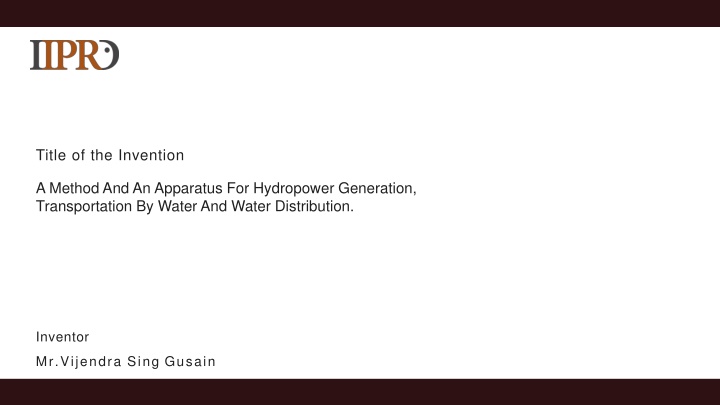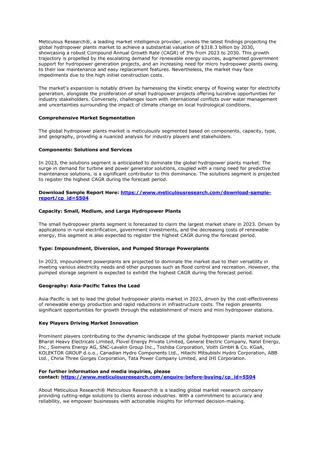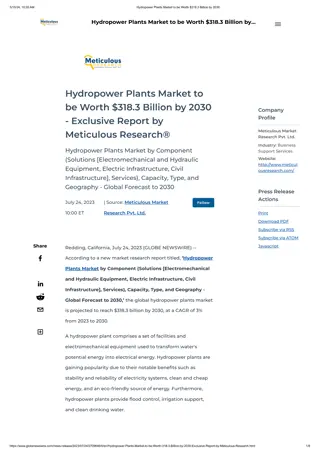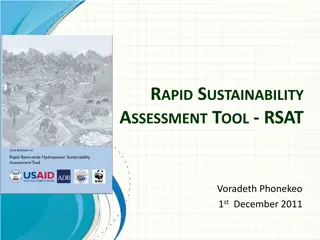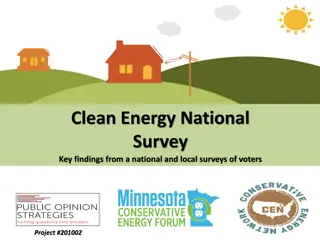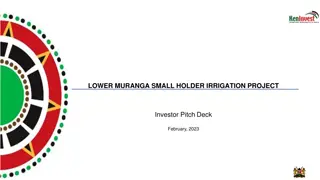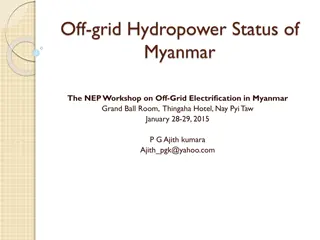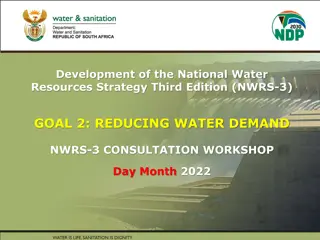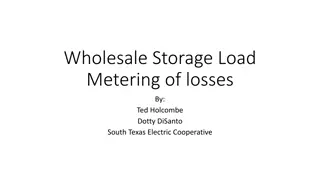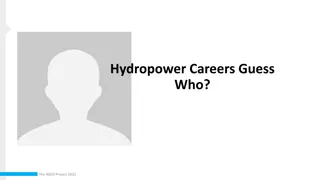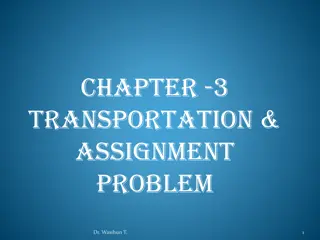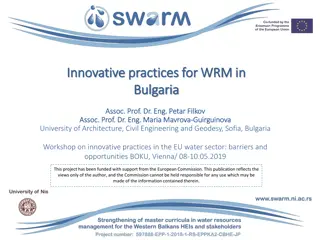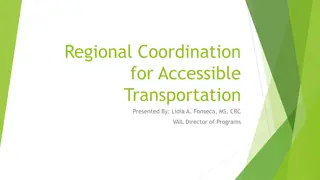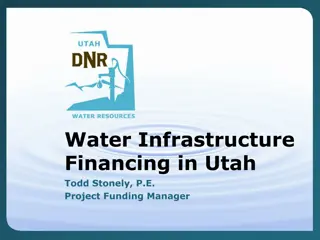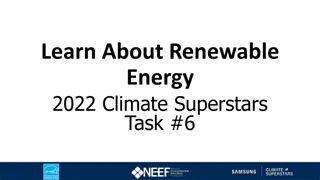Innovative Hydropower Generation and Water Transportation System
This invention by Mr. Vijendra Sing Gusain combines hydropower generation, water transportation, and distribution in one system. It offers advantages such as cost-efficiency, flexibility, and potential for enhancements through early-stage investment. Unlike traditional hydropower methods, this invention aims to address shortcomings associated with dams and reservoirs, offering a more sustainable approach to water utilization.
Download Presentation

Please find below an Image/Link to download the presentation.
The content on the website is provided AS IS for your information and personal use only. It may not be sold, licensed, or shared on other websites without obtaining consent from the author.If you encounter any issues during the download, it is possible that the publisher has removed the file from their server.
You are allowed to download the files provided on this website for personal or commercial use, subject to the condition that they are used lawfully. All files are the property of their respective owners.
The content on the website is provided AS IS for your information and personal use only. It may not be sold, licensed, or shared on other websites without obtaining consent from the author.
E N D
Presentation Transcript
Title of the Invention A Method And An Apparatus For Hydropower Generation, Transportation By Water And Water Distribution. Inventor Mr.Vijendra Sing Gusain
Technical Field of Invention: Development of a method and an apparatus for hydropower generation, transportation by water and distribution of water. The present invention integrates following into one system: a provision for transportation and navigation of animate and/or inanimate objects through water comprising of an inherent means for power generation and water distribution making use of an innovation structure arrangement. IPR Status: Application Number : 2226/MUM/2015 Published Date : 03 February 2017 Patent Pending Key Advantages Of Investing in Early Stage: Investing in the initial stage of such an exceptional technology is an opportunity to get licensing rights at an extremely cost efficient price. It provides flexibility for the modification as per requirements. Involvement of investor's Research and Development expertise, would further enhance the quality of product.
Background: Hydropower is used primarily to generate electricity. The most widely used categories of hydropower are: Conventional hydroelectric facility (referring to hydroelectric dams): Such system uses water stored in a dam, rate of flow of which is controlled by the opening water is used to propel turbine that generates electricity. of dam gate. The kinetic energy generated by flowing
Run-of-the-river hydroelectricity: Such system captures the kinetic energy in rivers or streams, without a large reservoir and sometimes without the use of dams.
Pumped-storage hydroelectricity: Such system stores water pumped uphill into reservoirs during periods of low demand to be released for generation when demand is high or system generation is low.
Problems: While there exist several methods for generation of hydropower, they have following shortcomings: Water flow in a stream can vary widely from season to season. Development of a hydropower site therefore requires analysis of flow records, sometimes spanning decades, to assess the reliable annual energy supply. Dams and reservoirs, although, smoothing seasonal changes in water flow but they have significant environmental impact as they as do alteration of naturally occurring stream flow that could often result in occurrence of drought and flood. Since, dams require vast space of land for their construction and installation, they often result in displacement of human settlement around the banks of water bodies.
Key Features of invention: Integrating following systems into one system: a provision for transportation and navigation of animate and inanimate objects through water comprising of an inherent means making use of an innovative structural arrangement, thus making it economic and efficient. for power generation andwater distribution Hydropower generated by the water channel network and thus does source of energy, thus achieve a self sufficiency by use of renewable sources. not require external non-renewable Direction, velocity and pressure of water can be monitored and controlled. A single system that addresses the need of water distribution, water purification, transportation by means of water and hydropower generation which is coordinated and controlled throughout. Apparatus used is very much economical and affordable. Key Advantages: Hydropower Generation Electric Transportation Water Distribution Water Filtration
Key Components of the invention: Network of channels: The channels would be used for distribution of water and transportation and navigation of animate or inanimate objects by transportation means (the vehicle/vessel and the passengers/cargo) through water. The network essentially would comprise of artificial water channels those run across the length and breadth of the said network. Such network could be constructed or installed over the ground at a height, on the surface of the ground or underground. Junction: The point where two or more channels forming a network intersect would serve as control station, and termed as Junction. Each control station would receive water from atleast two or more different channels flowing in different directions, and could be operated manually or automated by means of an Information Technology enabled setup. Each control station would comprise of: a control unit, water storage unit power generation unit parking unit for housing/parking the transportation means/vehicles. Gate: At the entry and exit point of each water channel a gate would be provided for controlling the flow, velocity and pressure of water exiting a water channel at every control station which would help to control and/or maximize the hydropower generated at each control station and power generation would be adjusted by varying the velocity head, gravitational head and the pressure head in the channels at appropriate levels of the network to give desired output and also the hydropower generated at each of the control stations would help in running the system.
Key Components of the invention: Transportation means: Transportation means could be boat shaped and could be constructed by using the materials used in the construction of boats with the dimensions and weight according to suit the channel dimensions and the water depth in the channel. The transportation means would be provided with fender or cushions on its outer surface to avoid and/or reduce any damage that maybe caused to the transportation means or the channel caused by rubbing of the transportation means against the surface of the channel. Water Purification Unit: Water Purification Unit would be an integral part of Water Storage Unit, which would purify the water stored therein and the purified water could be re-distributed across the network to different regions depending on the requirements. The impure water from the said water bodies could be made to flow through the channel for purification at the control stations installed with a purification unit and would be supplied back to the water body once purified. Power Generation Unit: Power Generation Unit would be installed at each junction. This unit would generate hydropower from the water coming from two or more channels. Generated Power would help in running the system.
Working of System: Water supplied to channels would flow across the entire network. Source of water could be an available natural or artificial source. The channels forming the network may be constructed with a slope to transport water and the transportation means in respective directions smoothly. Water entering the Control Station would be used for generating hydropower in two stages: First Stage: At the entry point of control station, a portion of water would be utilized for generating hydropower. Second Stage: Going further, slope of the channel would increase so that water flows under high pressure and with high velocity into the control stations thereby generating a large amount of hydropower. Each of the water channel would be divided across its length by means of a partition to form at least two sections, wherein one section of the channel would be used for navigation of the transportation means and the other section of the channel would be used for the purpose of distribution of water and generating hydropower. The transportation means may be operated manually or may be automated. The power required to run the transportation means would be derived from the power trapped at the control stations which is supplied to the transportation means from the control unit through cables. The velocity and direction of the transportation means in the channels could be controlled by means of the said cables and this would enable to transport objects in any direction of the network unlike in the rivers where the transportation means/vehicle is able to move only in the direction of the flow of water.
Working of System: The control stations would be provided with parking units for parking/housing the transportation means which may be loaded and unloaded. The water storage unit would contain water purification unit that would purify the water stored therein. The purified water could be re-distributed across the network to different regions, wherein impure water from the said water bodies could be made to flow through the channel, purified at the control stations installed with a purification unit and supplied back to the water body once purified. This would enable the distribution of water along with its purification. Application: Over the years, we have been dependent on fossil fuels for meeting our power needs. But the use of such fuels has led to some serious consequences like "Climate Change" issues. The world is now looking for the sustainable sources of energy which can fulfill their need without causing harm to the environment. The concept of developing the Smart Cities is globally being adapted. These smart cities are capable of generating the clean power on its own. Planning of smart cities is done in such a manner that it has least transportation problems, water problems, and power problems. But major cities like Mumbai, Bangalore, Delhi, Kolkata are facing various similar issues like transportation problems, rivers getting toxic, water shortage, power shortage, and the count goes on. With the tremendously large population settling in these cities every year, if these issues would not be fixed in time then the situation could become horrible. The above discussed invention is precisely designed to tackle all the discussed issues. This invention provides a complete solution for Transportation, Hydropower Generation, Water Distribution by connecting various water bodies, and Water Filtration.
Some of the key applications of this invention are discussed below: Transportation: Highlights: 1) Economical in Long Run. 2) Self Power Generation. 3) Uses Clean Energy. 4) Enables Transportation in Uneven Landscape. 5) Exclusively New Domain. 6) Would Reduce On-Road Congestion. Our invention provides a unique solution for demolishing of traffic congestion. Implementation of transportation through water channels would minimize the on-road traffic. Additionally, self generation of the power required to run this system, and that too using clean energy would enable this technology to successfully operate for a long run.
Water Distribution: Countries, like India, have vast diversity in water density across the geography. As a consequence, some areas suffer from flood while other areas suffer from drought. The only solution for overcoming such issues is to connect the water bodies and enable its uniform distribution. But geographical challenges like different kind of terrain all over the country doesn t make it a simple task. Our technology enables the construction of water channels in almost every condition, whether it is at slope or at plain areas. This opens up a wide possibility of implementing this technology in almost any kind of area. Generation of hydropower, transportation through water channels, and water filtration are some other added advantages that would benefit the local civilization residing near the Junctions of this system. After the implementation of this technology, we can expect a steep decline in the flood and drought frequency that would relieve the burden from government, for providing the compensation to victims. Due to uniformity in water distribution, agricultural issues could also be resolved that would consequently contribute in improving the National s GDP.
Expectations: Company seeks alliance with Potential Licensees to assign Licensing Rights to market these technologies. Company is also interested in Technical Collaboration and Economic Cooperation. Target Industry: Like Minded Innovators and Entities Companies in the domain of Smart Cities Construction Real Estate Industry Transportation Industry (Including Automobiles) Information Technology Industry (IT)
